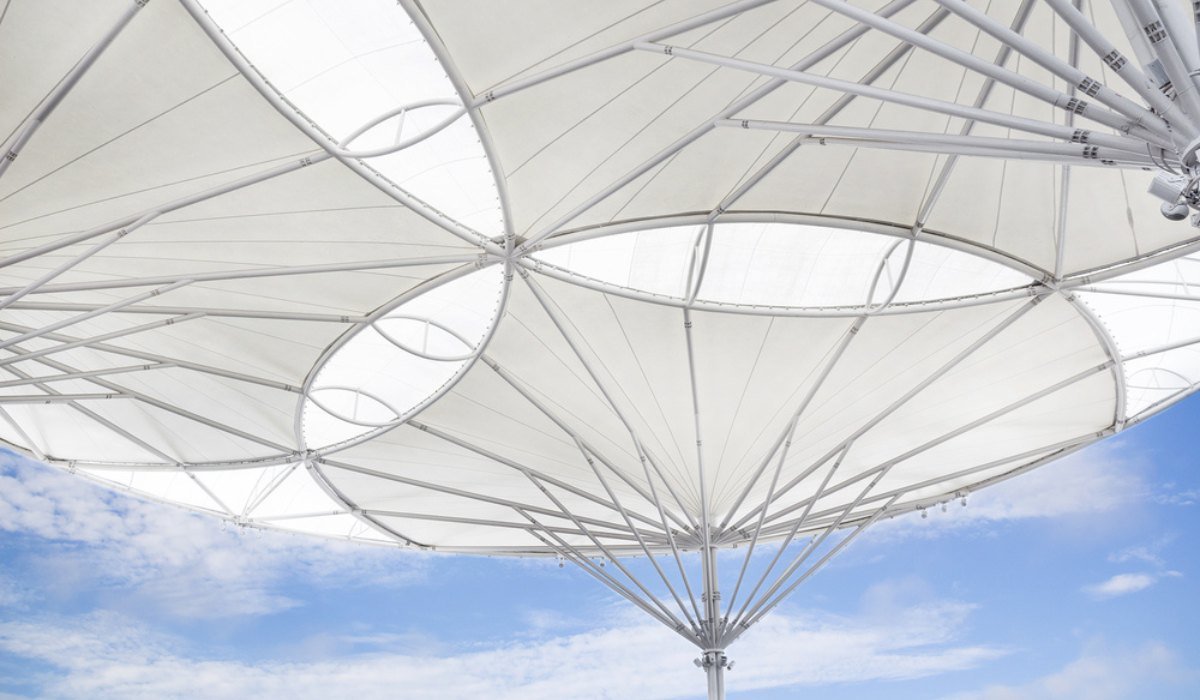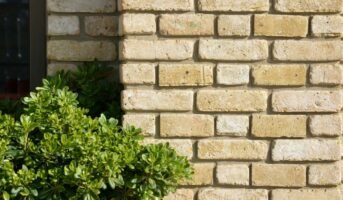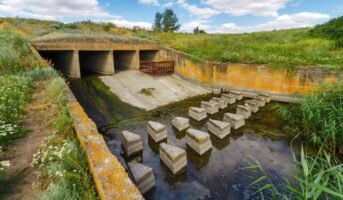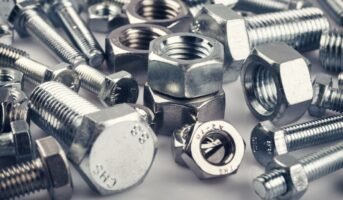Tensile structures, also known as tension structures, rely on tension to maintain their shape and stability rather than compression or bending. The concept of tensile structures dates back to the 19th century with canvas tents and awnings. In the mid-20th century, British engineer and architect Sir Norman Foster popularised the use of tensile structures in modern architecture through his innovative designs. Today, tensile structures are widely used in various applications, including tents, sports facilities, transportation terminals, and outdoor arenas.
They offer a unique combination of versatility, durability, and aesthetic appeal, making them an ideal choice for many structures. Tensile structures are also environmentally friendly, often using less material than traditional building methods and requiring less energy to construct. With the growing demand for sustainable and visually appealing structures, the use of tensile structures continues to gain popularity in the world of architecture and construction.
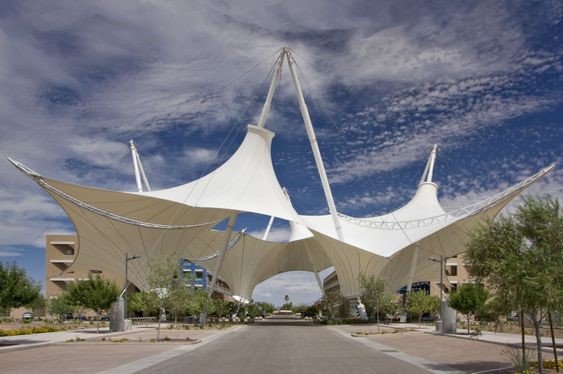
Source: Pinterest
See also: Load bearing structures: Types and advantages
Tensile structure: Materials used
Tensile structures are built using a range of materials, such as:
- Fabric: PVC-coated polyester, PTFE (Teflon) coated glass fibre, or ETFE (ethylene tetrafluoroethylene) are the most commonly used materials for fabric in tensile structures. These materials are lightweight, durable, and weather-resistant.
- Steel: Steel is used as a framework for tensile structures, providing the necessary strength and stability. Steel cables, rods, or pipes create the structural frame, while steel fittings, connectors, and clamps hold everything together.
- Aluminium: Aluminium is a popular choice for tensile structures because of its light weight and strength. It is used for the frame and cables and can also be used for the connectors and clamps.
- Glass fibre: Glass fibre is used to manufacture cable nets and mesh systems. It is strong and flexible, making it ideal for tensile structures.
- Concrete: Concrete anchors and footings are used to secure tensile structures to the ground. Concrete is also used to create ballast blocks, which provide weight and stability.
- Membranes: Membranes are used for the roofing of tensile structures. They are made from various materials, such as PVC, PTFE, or ETFE and can be translucent or opaque.
These materials are used in combination to create tensile structures that are strong, durable, and aesthetically pleasing.
Tensile structure: Types
Tensile structures are engineered structures designed to withstand tension forces. They are often used in architectural design to create unique and visually appealing structures and provide shade, shelter, and protection from the elements.
Here are some of the different types of tensile structures:
Surface-stressed tensile structures
Surface-stressed tensile structures are architectural designs that rely on tension to provide stability. It is achieved by stretching a membrane or fabric material between support points. The fabric is typically made of PVC, PTFE, or ETFE and is stretched tightly to create a taut, drum-like surface. The membrane is held by cables, ropes, or rods anchored to the ground or surrounding structure. These structures can be used for various purposes, including shade, shelter, and aesthetic appeal. They can be found in various settings, such as parks, public squares, and commercial buildings. Due to their ability to cover large areas with minimal material, they are often used in sustainable architectural design.
Linear tensile structures
Linear tensile structures are architectural designs that use tension in cables, ropes, or fabric to support a structure. They are commonly used for shading and covering outdoor spaces, such as patios, courtyards, and walkways. They can also be used for indoor applications such as atriums and exhibition halls. The key components of a linear tensile structure include support points, cables, and covering material.
The cables are attached to anchor points, such as columns or building walls, and then tensioned to provide stability. The covering material is then attached to the cables to create a flat or curved surface. The design of linear tensile structures allows for flexibility, creativity, and cost-effectiveness. They are also a sustainable and environmentally friendly alternative to traditional building materials.
Three-dimensional tensile structures
Three-dimensional tensile structures are innovative structures made of tension elements such as cables, ropes, and fabrics, supported by minimal compression elements. These structures are designed to resist large loads using only the tension force, making them lighter and more flexible than traditional structures. The three-dimensional form of these structures provides ample surface area for solar panels, shading, and rain protection, making them suitable for various applications, including roofing, shading, and event structures.
These structures are also customisable and can fit any shape, size, or colour, making them ideal for architectural and design purposes. With their versatility, durability, and aesthetic appeal, three-dimensional tensile structures are becoming increasingly popular in construction projects worldwide.
Tensile structure: Applications
Tensile structures are versatile and have various applications in various industries. Some of the most common applications of tensile structures are:
- Architecture: Tensile structures are often used as canopies, roofing systems, and shading devices for outdoor spaces, such as patios, courtyards, and pools. They are also used as large tent-like structures for weddings and outdoor concerts.
- Sports: Tensile structures are commonly used for sports facilities, such as tennis courts, swimming pools, and track and field venues. They are used for shading the athletes and spectators and providing shelter during inclement weather.
- Agriculture: Tensile structures are used in agriculture for covering crops, such as greenhouses, shade houses, and polytunnels. It helps protect the crops from harsh weather conditions and allows farmers to control the microclimate.
- Transportation: Tensile structures are used in the transportation industry to cover railway platforms, bus stops, and parking areas. They provide shelter to passengers and protect them from the elements.
- Industry: Tensile structures are used in various industrial settings, such as warehouses, manufacturing facilities, and storage yards. They provide a cost-effective and flexible solution for covering large areas.
Overall, tensile structures are a versatile and cost-effective solution for many applications requiring a flexible, lightweight, and durable covering system.
Tensile structure: Advantages
Tensile structures have several advantages, making them a popular choice for architectural design and engineering. Some of the key benefits are:
- Durability and longevity: Tensile structures are made from high-quality materials that are strong, durable, and resistant to weather and environmental conditions, making them long-lasting and low maintenance.
- Cost-effectiveness: Tensile structures are typically less expensive than traditional building materials, making them a cost-effective option for large projects.
- Versatility: Tensile structures can be designed and built in a wide range of shapes and sizes, making them suitable for a variety of applications, such as canopies, tent-like structures, and large-scale roofs.
- Natural light: Tensile structures allow for maximum natural light, reducing the need for artificial lighting and energy costs.
- Aesthetics: Tensile structures are sleek and modern, adding a unique and eye-catching element to any building or space.
- Easy installation: Tensile structures can be installed quickly and efficiently, reducing construction time and labour costs.
- Sustainability: Tensile structures are often made from recyclable materials, making them a more sustainable option for the environment.
- Flexibility: Tensile structures can be designed to withstand wind, snow, and other environmental elements, making them suitable for use in a variety of climates and locations.
Tensile structure: Limitations
- Limited size and span: Tensile structures are typically smaller and have limited spans, making them less suitable for large-scale applications.
- Expensive: The cost of designing and constructing tensile structures is often higher than other types.
- Maintenance: Tensile structures require regular maintenance and cleaning to maintain their appearance and structural integrity.
- Weather sensitivity: Tensile structures are vulnerable to extreme weather conditions, such as high winds, heavy snow, and lightning strikes.
- Material limitations: Tensile structures are usually made of lightweight materials, making them less durable and susceptible to damage.
- Aesthetic limitations: Tensile structures have limited design options and are often viewed as less aesthetically pleasing than other structures.
- Lighting limitations: Lighting options for tensile structures are limited, making them less suitable for illuminated applications.
- Permitting: Obtaining permits and approvals for tensile structures can be more complicated and time-consuming than for other structures.
FAQs
What is a tensile structure?
A tensile structure is a construction held up by the tension of flexible materials, such as fabric or cables, and not by compression or bending. These structures are commonly used for shelters, shades, and canopies.
What materials are used to make a tensile structure?
Tensile structures are typically made from high-strength materials such as steel, aluminium, or stainless steel cables and weather-resistant fabrics such as PVC-coated polyester or Teflon-coated fibreglass.
Are tensile structures waterproof?
Most tensile structures are designed to be weather-resistant, and many fabrics used to cover them are water-resistant, but they may not be completely waterproof. Waterproof coatings can be added to the fabrics to increase their resistance to water.
What is the lifespan of a tensile structure?
A tensile structure's lifespan depends on the materials' quality and maintenance practices. A well-maintained tensile structure can last for 20 to 25 years.
How do you maintain a tensile structure?
Maintenance of a tensile structure involves:
Regular cleaning.
Inspecting the cables and fabric for wear and tear.
Checking the anchors and fixings for stability.
It is also recommended to have the structure professionally cleaned and inspected every 5 to 10 years.
Can tensile structures be used for permanent structures?
Yes, tensile structures can be used as permanent structures, but they must be designed and installed by experienced professionals to ensure their stability and durability.
| Got any questions or point of view on our article? We would love to hear from you.
Write to our Editor-in-Chief Jhumur Ghosh at [email protected] |
Housing News Desk is the news desk of leading online real estate portal, Housing.com. Housing News Desk focuses on a variety of topics such as real estate laws, taxes, current news, property trends, home loans, rentals, décor, green homes, home improvement, etc. The main objective of the news desk, is to cover the real estate sector from the perspective of providing information that is useful to the end-user.
Facebook: https://www.facebook.com/housing.com/
Twitter: https://twitter.com/Housing
Email: [email protected]
